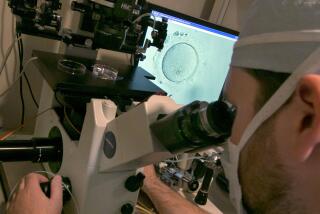Click Here for Help on Fertility Issues
- Share via
Resolve: The National Infertility Assn.
https://www.resolve.org
Background: Founded in 1974, and now comprising some 50 chapters nationwide, Resolve is a vast, nonprofit support system for men and women with fertility problems. Its Web site functions as a library and advocacy center for consumers and fertility professionals.
What Works: Resolve has been operating a national infertility hotline for years, and its experience shows. The site’s page on general information begins by posing the question: How do I know if I have an infertility problem? The answer: When there’s no baby after one year of well-timed, unprotected intercourse. The site is equally blunt and practical when discussing ovulation, the timing of sex, possible causes of infertility and which tests doctor should perform when diagnosing it, from blood tests to semen analysis to biopsy of the uterine lining. Resolve also has information on clinical trials, support groups, buying fertility drugs online, and how to cope with the holidays. You don’t have to say yes to every party invitation, it advises, especially when there will be lots of kids and pregnant women there.
What Doesn’t: One of the most exasperating and frightening aspects of being unable to conceive is the treatment industry--the high-priced, and sometimes seemingly shady, world of hormone injections, sperm banks and in-vitro techniques. How can you tell whether a clinic is trustworthy? How do you assess the reported success rates of various techniques? The site could do a better job of preparing people to critically assess these establishments. And as fluent as it is discussing basic questions and answers, the site is less consumer-friendly when plunging into the science of infertility. Its page on embryo implantation, for example, is full of good science and is plenty readable--for a reproductive researcher.
*
The American Society for Reproductive Medicine
https://www.asrm.org
Background: The ASRM is a nonprofit coalition of doctors, embryologists, veterinarians and other reproductive specialists devoted to fueling interest in fertility problems and their treatment, as well as funding research. Its Web site provides information for consumers and specialists while highlighting the society’s activities.
What Works: The “frequently asked questions” are good ones, including, “Does in-vitro fertilization work?” and “Is it expensive?” The answers: Yes, in vitro produces a baby about 22% of the time, which is about the same rate that fertile couples reproduce in a given cycle; and yes, again, it costs an average of about $8,000 per cycle. As a rule, the site explains, insurers don’t pay all the costs. Yet state laws vary in this area, and the ASRM helpfully provides a guide to those laws in the states that have them. Also, there’s a page here detailing how to grill infertility specialists about what’s involved, how much it will cost, how success is measured and what it means. Before paying $8,000 per cycle, these are things you need to know.
What Doesn’t: The coverage of research is spotty on this site, and there’s no reason it should be. The ASRM publishes one of the premier journals in the field, it makes research grants, and it should be able to deliver readable, ongoing coverage of what’s being explored. To couples longing for a child, after all, the latest experiments and even basic cell research are of burning interest. The site does contain a highlights page from the journal, buried in the media section, but the reports are short and lack the kind of context that couples want and need. There’s also a promotional subtext here, a note of approval in the discussion of fertility techniques that leaves little room to discuss the risks of drug treatments, for example, or even of the various diagnostic tests.






